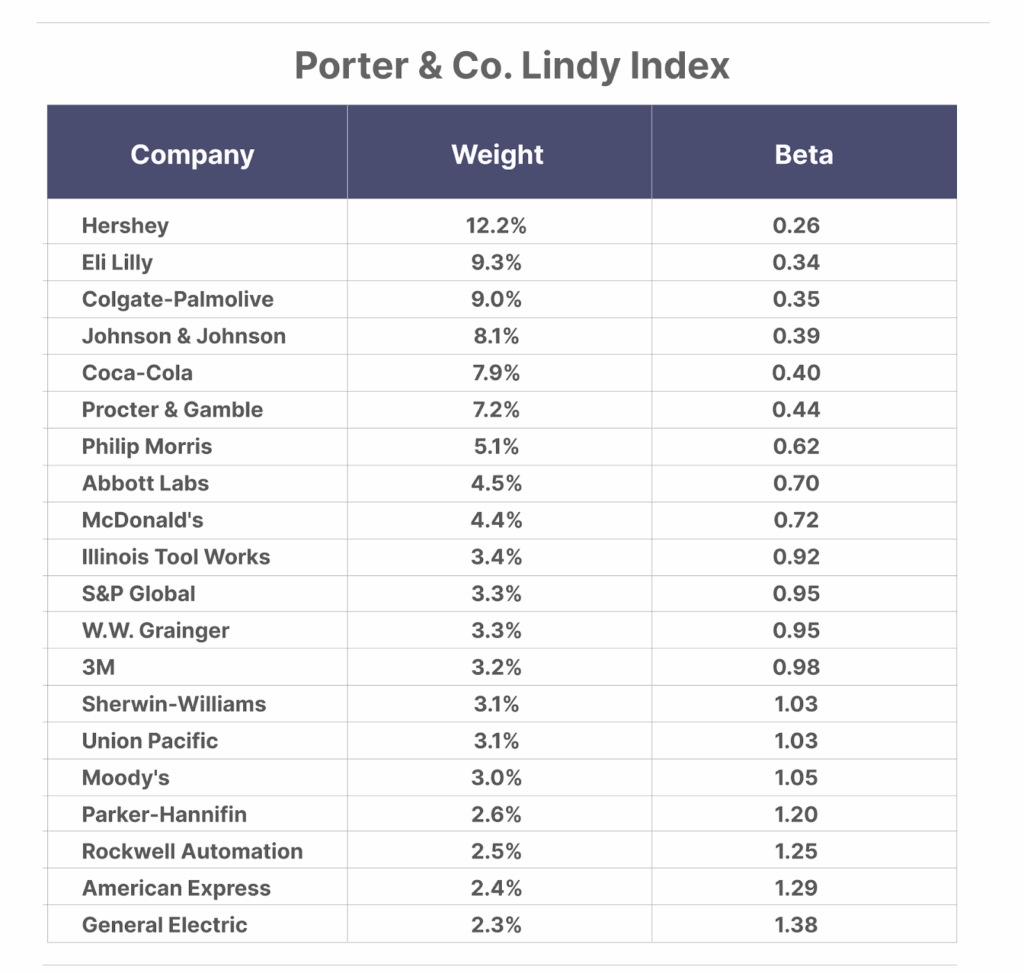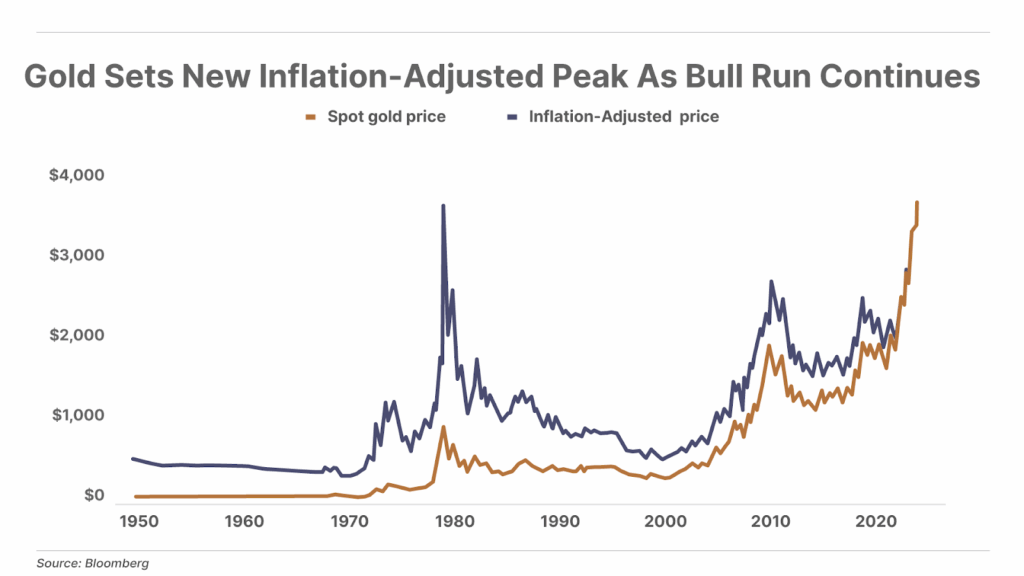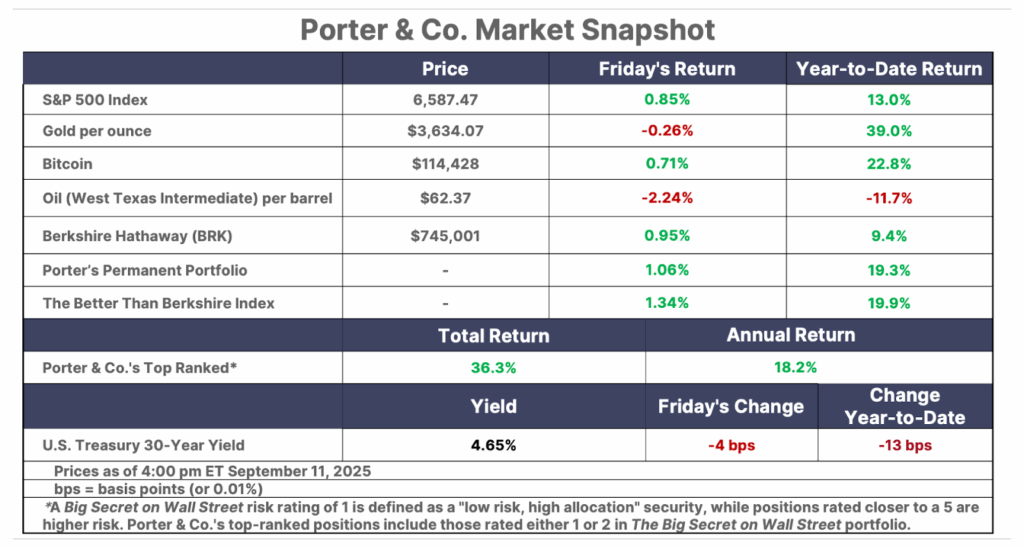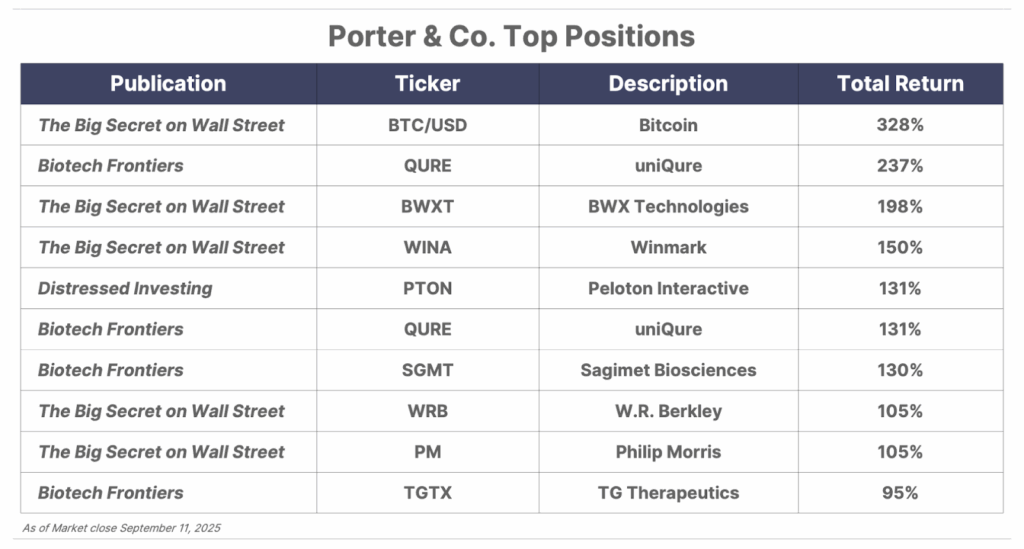Issue #105, Volume #2


How To Take Lindy Investing To The Next Level
This is Porter’s Daily Journal, a free e-letter from Porter & Co. that provides unfiltered insights on markets, the economy, and life to help readers become better investors. It includes weekday editions and two weekend editions… and is free to all subscribers.
| Bridgewater’s All Weather Fund… Harry Browne’s Permanent Portfolio… The Lindy Effect… Market-beating returns with much less risk… A booming money supply… |
Oh, wait until you see this…
Our Annual Conference is fast approaching (less than two weeks away!), and I’ve made an incredible breakthrough in our Lindy strategy research, which I’ll explain below.
If you’ve read my recent essays about The Solution or my Adler mentors, you’ve seen where I’m heading with my presentation at this year’s conference.
We’re trying to build a vastly better way to invest: a way that can deliver ultra-low volatility returns (like bonds) but with better-than-stock-market returns (20%+).
Most people don’t believe consistent, market-beating results are possible without market levels of risk. Even so, there are plenty of real-world proofs of concept, like Bridgewater’s All Weather Fund and my mentor Harry Browne’s Permanent Portfolio Fund (PRPFX).
These funds all use multiple asset classes (stocks, bonds, precious metals) to balance the volatility of the different investments against each other. The resulting portfolio delivers ultra-low volatility results. The strategy is perfect for people who want equity-like returns, but can’t – usually because of age – tolerate equity-market volatility and risk.
But what about people who are seeking better-than-equity returns…?
Last year at our conference, I unveiled my first-ever Permanent Portfolio. It used multiple uncorrelated asset classes (bonds, gold, Bitcoin) to produce better-than–equity returns (over 20%+ in the last year) with only bond market levels of volatility (about half the volatility of the stock market.)
And this year, I want to improve on these results.
Porter, that’s impossible…
No, it’s not. And this year, I want to show you how to get returns like these by investing only in stocks!
For those of you leery of trying to understand insurance companies (which I use as a proxy for bonds in Porter’s Permanent Portfolio), or for those of you unwilling to own gold or Bitcoin, this new approach might be the perfect solution. This strategy will allow you to continue to get rich in stocks, without the risk of a big drawdown that destroys your retirement savings.
At the core of this new strategy is something called The Lindy Effect.
The Lindy Effect is based on proven statistical observations that the longer things (specifically, non-organic things) have been around, the longer they’re likely to stick around.
For example, if a book, technology, or tradition has been popular for 50 years, it’s more likely to last another 50 years compared to something brand new. The reasoning is that things that survive for a long time have proven they’re useful, durable, or valuable, while new things haven’t yet been tested by time.
For the statisticians in the audience, the Lindy Effect is rooted in power-law distribution survival times. And we know, from decades of observations, that public companies follow a definite Pareto Law power distribution, with a very small percentage of all the companies earning the most and surviving the longest.
If the survival time of a public company follows a power-law distribution, the conditional probability of surviving an additional time decreases more slowly than in normal distributions. Specifically, for power-law distributions, the expected remaining lifespan scales with the current age, leading to the Lindy heuristic.
Again, all you need to know is that, according to the theory, longer survival indicates an entity’s robustness, increasing its expected future survival.
In short: investors looking for power-law outcomes in their portfolio ought to carefully consider corporations that have thrived for extremely long periods.
Last year, we used this concept to build out the equity portion of Porter’s Permanent Portfolio. And the results were excellent. Out of 11 positions, we’re only down on one – Coke (NYSE: KO) is down 4%. Overall, the average return was 27.6%, with highlights being one of the oldest businesses in the United States, EQT (NYSE: EQT), up almost 50%, and Philip Morris International (NYSE: PM), one of the oldest consumer products brands in the world, up 40%.
This year, I’ve been working hard to build out a more robust, 20-position Lindy Index that we can track (like we do with our Better Than Buffett Index) to demonstrate, in real time, the value of our research. While I’m not 100% finished vetting this, here’s where I am now.

As you know, “Lindy investing” uses the longevity of a business as the primary criterion. Surviving multigenerational disruption and repeated economic shocks is rare, and, according to the Lindy theory, it is a powerful predictor of future resilience. Thus, this index was built using companies with a minimum of 80 years (!) of successful operations.
These are America’s highest-quality, time-tested businesses. These companies have outlasted trends and fads. They benefit from deep-rooted competitive advantages, brand equity, and operational excellence. Lindy businesses survive because they are able to adapt, reallocate capital astutely, and defend their business models.
In addition to selecting for ultra-long-lived businesses, the index was made using a qualitative overlay for brand strength, long-term return on equity (“ROE”), critical market function, and recurring revenue. The specific portfolio weights were determined by volatility (observed beta), with the largest allocations going to the least volatile stocks. This risk-weighting amplifies risk-adjusted returns and allows market forces to guide the index composition.
In the back testing I’ve done so far, over the last 10 years, this portfolio (rebalanced annually) produced a total return of 158.1% (annualized returns were 10%), with a beta of only 0.51 (half the risk of the stock market), and a maximum drawdown of only 17%. On a risk-to-reward basis, this performance was all-world with a Sharpe Ratio of 1.58.
Right about now, I suspect most of you are saying… wait a minute, Porter… what’s so great about these results? And, sure, I get it – to most of you earning 10% a year (on your entire portfolio) isn’t anything to jump up and down about.
Hang on though, I don’t think you’re really thinking this through.
With this kind of a set-it-and-forget-it index approach, you don’t have to do any research – these stocks won’t change much, if at all, over the next decade. This approach requires a small amount of trading, once a year. That’s it. And this is a 100% stock approach – there’s no offsetting gold, bond, or cash. That’s 100% of the stock market’s average performance, with only half the risk. And there’s nothing to it – just paint by numbers and go back to sleep.
That’s a great solution for a lot of investors. And if you think carefully about what this means, you might see something truly incredible. With a maximum drawdown of less than 20% and with such little volatility, this portfolio is much more like a stable asset than any stock. If you had a house you knew would appreciate at 10% a year, how much mortgage (at 5%) would you use to buy it?
In this case, if you had invested $1 million into this index a decade ago and then borrowed another $1 million to invest alongside your equity (2x leverage), you would have earned about 18% a year (including borrowing costs). The volatility of the portfolio would still be less than the stock market’s. And your maximum drawdown would have been about 34% – the same as the S&P 500’s.
In other words, by selecting the highest-quality, lowest-volatility stocks with Lindy characteristics, you can build a portfolio that will either protect your wealth completely… or help you build wealth reliably.
That’s The Solution.
And, next week, I’ll show you something even better…
There’s a simple adjustment to this strategy that produced 17% annual unleveraged gains with less volatility than the stock market (beta: 0.88).
No doubt, many of you are much better investors than I am. But earning these kinds of returns from an ultra-safe portfolio of low volatility stocks seems like the Holy Grail of investing to me.
And, when you combine these new powerful indexes with our Permanent Portfolio framework, even better results are possible.
Can’t wait to see everyone at the farm!
Is the World’s Greatest Investor About To Shock Wall Street?
In just a few weeks, a move decades in the making could be revealed — and when it is, it could ignite the next great gold rush. Savvy insiders are quietly positioning now… before Buffett makes it official. Garrett Goggin has already pinpointed four tiny-gold-miners that could 100X once the announcement hits. It’s the perfect moment to be greedy — before the herd wakes up.
Click here to get Garrett’s Top Four gold picks now — before the world’s greatest investor pulls the trigger.
Three Things To Know Before We Go…
1. Inflation continues to trend higher. The Consumer Price Index rose 0.4% month over month, the sharpest increase since the start of the year, bringing inflation to 2.9% year over year. While inflation is still well above the Fed’s 2% target, signs of economic strain are growing as revisions erased hundreds of thousands of reported jobs. Recent producer price and labor data point to a cooling economy – potentially giving the Fed room to ease without stoking another wave of inflation. Markets are now assigning a 93% probability of a 25-basis-point cut at next week’s September meeting.
2. Money supply is soaring. Global money supply rose to a new record of $140 trillion in July, a 9.3% year-over-year increase. More than $40 trillion – 30% of this total – has been added to global economies since COVID, with $10 trillion added since the beginning of 2025 alone. The debasement of fiat currency is accelerating.

3. Inflation-adjusted gold prices hit a 45-year record high. In January 1980, gold reached $850 per ounce – equivalent to $3,590 in today’s dollars – during one of the most turbulent periods in U.S. economic history, marked by a collapsing currency, runaway inflation, and recession. Today, with gold trading around $3,650 per ounce, it has surpassed that milestone and is up 39% year to date. With rate cuts on the horizon and inflation showing little sign of slowing, the bull market for gold and other hard assets appears far from over.

Tell me what you think: [email protected]
Good investing,
Porter Stansberry
Stevenson, Maryland


Please note: The investments in our “Porter & Co. Top Positions” should not be considered current recommendations. These positions are the best performers across our publications – and the securities listed may (or may not) be above the current buy-up-to price. To learn more, visit the current portfolio page of the relevant service, here. To gain access or to learn more about our current portfolios, call our Customer Care Team at 888-610-8895 or internationally at +1 443-815-4447.
